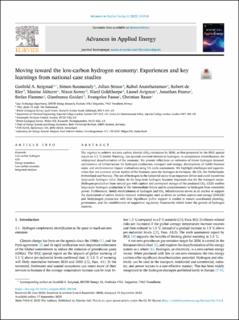| dc.contributor.author | Reigstad, Gunhild Allard | |
| dc.contributor.author | Roussanaly, Simon | |
| dc.contributor.author | Straus, Julian | |
| dc.contributor.author | Anantharaman, Rahul | |
| dc.contributor.author | de Kler, Robert | |
| dc.contributor.author | Akhurst, Maxine | |
| dc.contributor.author | Sunny, Nixon | |
| dc.contributor.author | Goldthorpe, Ward | |
| dc.contributor.author | Avignon, Lionel | |
| dc.contributor.author | Pearce, Jonathan M | |
| dc.contributor.author | Flamme, Stefan | |
| dc.contributor.author | Guidati, Gianfranco | |
| dc.contributor.author | Panos, Evangelos | |
| dc.contributor.author | Bauer, Christian | |
| dc.date.accessioned | 2022-11-03T09:19:21Z | |
| dc.date.available | 2022-11-03T09:19:21Z | |
| dc.date.created | 2022-09-19T14:03:38Z | |
| dc.date.issued | 2022 | |
| dc.identifier.issn | 2666-7924 | |
| dc.identifier.uri | https://hdl.handle.net/11250/3029759 | |
| dc.description.abstract | The urgency to achieve net-zero carbon dioxide (CO2) emissions by 2050, as first presented by the IPCC special report on 1.5°C Global Warming, has spurred renewed interest in hydrogen, to complement electrification, for widespread decarbonization of the economy. We present reflections on estimates of future hydrogen demand, optimization of infrastructure for hydrogen production, transport and storage, development of viable business cases, and environmental impact evaluations using life cycle assessments. We highlight challenges and opportunities that are common across studies of the business cases for hydrogen in Germany, the UK, the Netherlands, Switzerland and Norway. The use of hydrogen in the industrial sector is an important driver and could incentivise large-scale hydrogen value chains. In the long-term hydrogen becomes important also for the transport sector. Hydrogen production from natural gas with capture and permanent storage of the produced CO2 (CCS) enables large-scale hydrogen production in the intermediate future and is complementary to hydrogen from renewable power. Furthermore, timely establishment of hydrogen and CO2 infrastructures serves as an anchor to support the deployment of carbon dioxide removal technologies, such as direct air carbon capture and storage (DACCS) and biohydrogen production with CCS. Significant public support is needed to ensure coordinated planning, governance, and the establishment of supportive regulatory frameworks which foster the growth of hydrogen markets. | en_US |
| dc.description.abstract | Moving toward the low-carbon hydrogen economy: Experiences and key learnings from national case studies | en_US |
| dc.language.iso | eng | en_US |
| dc.publisher | Elsevier | en_US |
| dc.rights | Navngivelse 4.0 Internasjonal | * |
| dc.rights.uri | http://creativecommons.org/licenses/by/4.0/deed.no | * |
| dc.title | Moving toward the low-carbon hydrogen economy: Experiences and key learnings from national case studies | en_US |
| dc.title.alternative | Moving toward the low-carbon hydrogen economy: Experiences and key learnings from national case studies | en_US |
| dc.type | Peer reviewed | en_US |
| dc.type | Journal article | en_US |
| dc.description.version | publishedVersion | en_US |
| dc.rights.holder | The Authors | en_US |
| dc.source.journal | Advances in Applied Energy | en_US |
| dc.identifier.doi | 10.1016/j.adapen.2022.100108 | |
| dc.identifier.cristin | 2053140 | |
| dc.relation.project | EC/H2020/691712 | en_US |
| dc.relation.project | Norges forskningsråd: 328715 | en_US |
| dc.relation.project | Norges forskningsråd: 271498 | en_US |
| dc.source.articlenumber | 100108 | en_US |
| cristin.ispublished | true | |
| cristin.fulltext | original | |

